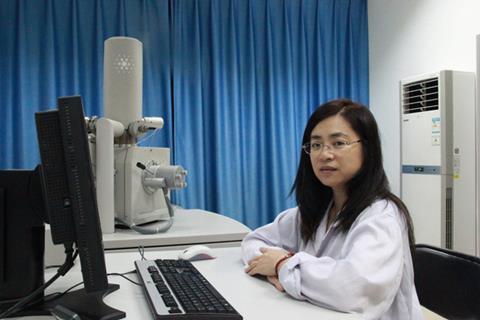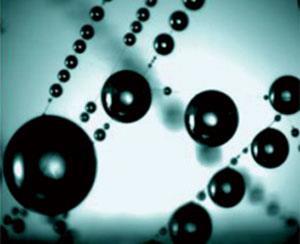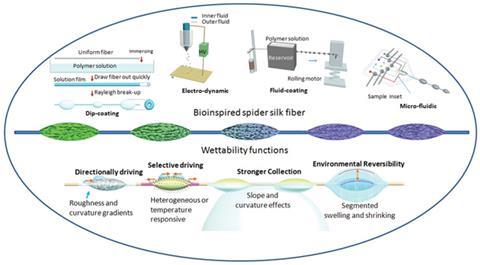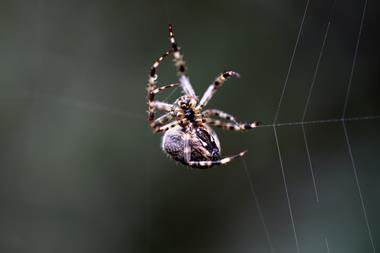Yongmei Zheng talks to Jennifer Newton about materials than can manipulate water droplets
Yongmei Zheng is a professor of chemistry at Beihang University in China. Research in the Zheng group looks at biological and bioinspired surfaces with wettability functions.

Who or what inspired you to become a scientist?
Nature – there is so much we can learn from it. Biological materials have a range of unimaginable but smart functions. It is my aim to reveal these biological phenomena to better the lives of human beings.
Can you give me a bit more detail on your overall research aims?
I hope to understand the natural laws of wettability on biological and bioinspired material surfaces. We use physical, chemical and nanotechnology methods to fabricate bioinspired functional surfaces with unique effects resulting from gradients in micro- and nanostructures, to find wetting mechanisms such as water repellency or water collection. We hope to develop these properties for possible applications.
You’ve done a lot of work trying to recreate the properties of spider silk – why is this such an interesting material?

After millions of years, many creatures have evolved ways of making filamentous fibres. These materials have been used in all sorts of applications including fabrics, medical wound dressings and military applications. Silks have excellent mechanical properties and chemical compositions. Spider silks are praised as unique natural biomaterials with characteristics at both the chemical and physical levels. They are undoubtedly the most excellent structural and functional materials in nature.
We discovered that the capture silk of the cribellate spider, Uloborus walckenaerius, collects water from air.1 Its unique micro- and nanostructure, which is characterised by periodic spindle-knots made of random nanofibrils that are separated by joints made of aligned nanofibrils, gives rise to a combination of gradients to achieve this cooperative effect that drives tiny water droplets (under 100µm in diameter) toward the spindle-knots for highly efficient water collection.
What is your research group working on at the moment?
Our group is working to reveal the cooperative effect of multi-gradient micro- and nanostructured (MN) interfaces on the surface of wettable materials – for example, how to use chemical gradients, physical gradients, geometric gradients and responsive wettability gradients, to control droplet behaviour.
We have found that a multi-gradient MN cooperative effect can break through unsolved problems regarding function on material surfaces, such as condensed droplet transport, hysteresis limitations and water repellency at low temperatures.
We are pursuing two main research routes regarding functional materials. One is characterising water collection in materials like spider silk by looking at droplet transport, droplet gathering and fogdrop harvesting from air. The other is characterising water repellency on materials like butterfly wings by looking at superhydrophobicity, anti-icing and ice-phobic effects.
Inspired by the role that micro- and nanostructures (MNs) play in the water collecting ability of spider silk we have designed and made a series of fibres2 by integrating fabrication methods and technologies, such as dip-coating, Rayleigh instability to break-up droplets and phase separation, alongside strategies that combine electrospinning and electrospraying, fluid-coating and wet-assembly.
Our structures can be tailored to demonstrate the mechanism of multiple gradients in driving tiny water droplets. Rough and smooth fibre surfaces, together with a chemical gradient, can generate movement and control water droplets.

In the case of larger water droplets, geometrically-engineered thin fibres have a much greater water capturing ability than previously thought. This is due to the increased stability of the phase contact line that combines ‘slope’ and ‘curvature’ effects on spindle-knots, providing sufficient capillary adhesion to retain the hanging droplets. To extend this functionality, we have made bead-on-string heterostructured fibres (BSHFs) out of poly-(methyl methacrylate) (PMMA) and titanium tetrachloride (TiCl4) hydrolysed nanoparticles, via a one-step electrohydrodynamic method that combines electrospinning and electrospraying strategies. BSHFs can collect water by intelligently responding to environmental changes in humidity. We are also developing a wet-assembly technique that integrates electrospinning, particle fog and water condensation to create heterostructured nanofibres.3
Can you explain where your work looking at butterfly wings could be applied?
Butterfly wings have multi-level oriented, anisotropic, or step-like micro- and nanostructures on their surface to repel water in a particular direction.4 We have modelled the micro- and nanostructures of butterfly wings to obtain a bioinspired surface. The excellent water repellency of these bioinspired surfaces could have promising applications for controlling droplets in micro-fluidics as self-cleaning, anti-adhesion, anti-icing and anti-fogging surfaces.
What is the greatest challenge you face in your research at the moment?
The greatest challenge is developing ways to make robust and wettable materials on a large enough scale to actually be applied.
References
- Y Zheng et al, Nature, 2010, 463, 640 (DOI: 10.1038/nature08729)
- Y Chen and Y Zheng, Nanoscale, 2014, 6, 7703 (DOI: 10.1039/c4nr02064b)
- L Zhao et al, Chem. Commun., 2014, DOI: 10.1039/c4cc05156d
- Liu et al, ACS Nano, 2014, 8, 1321 (DOI: 10.1021/nn404761q); H Mei et al, Soft Matter, 2011, 7, 10569 (DOI: 10.1039/c1sm06347b); Y Zheng et al, Soft Matter, 2007, 3, 178 (DOI: 10.1039/b612667g)












No comments yet